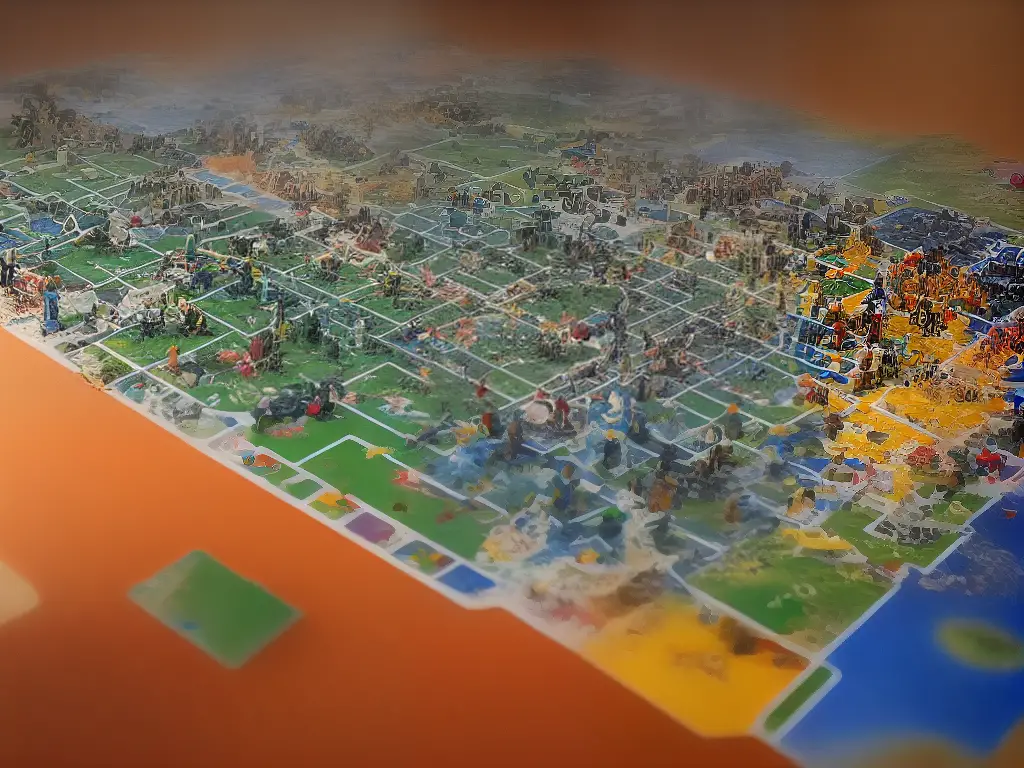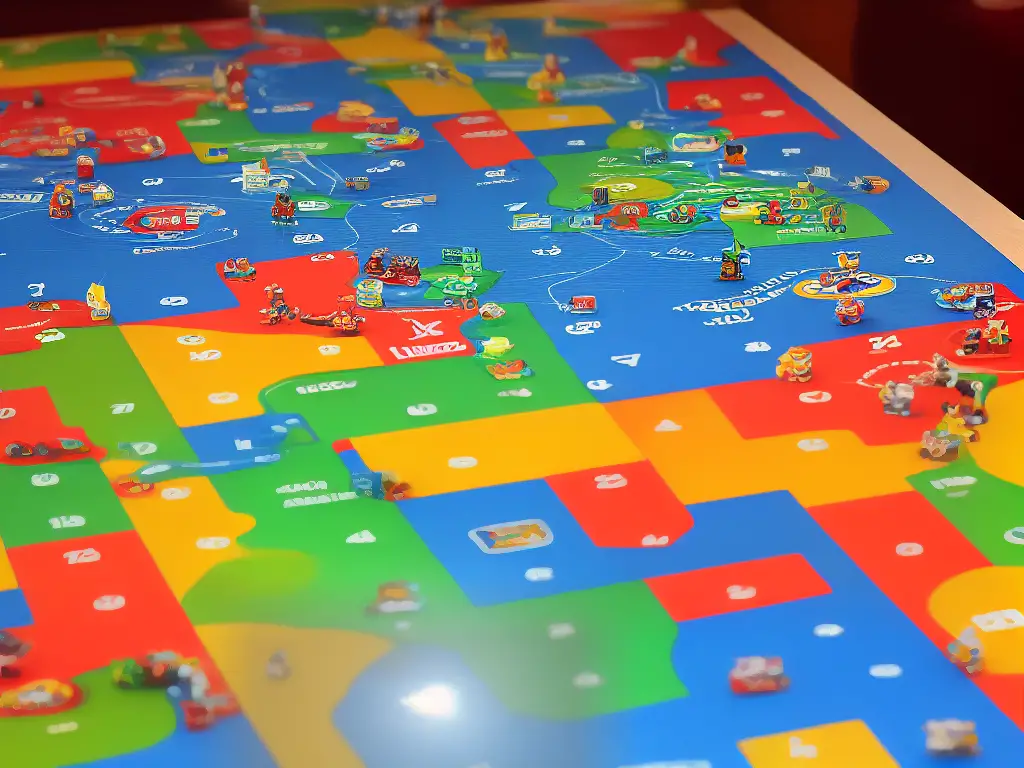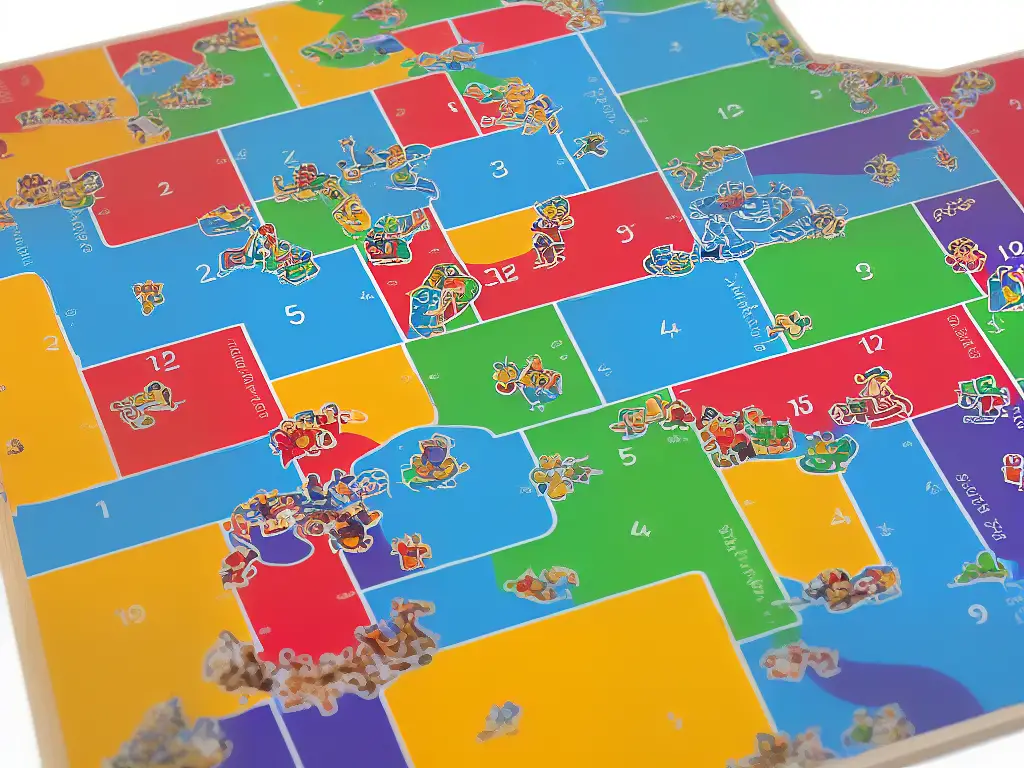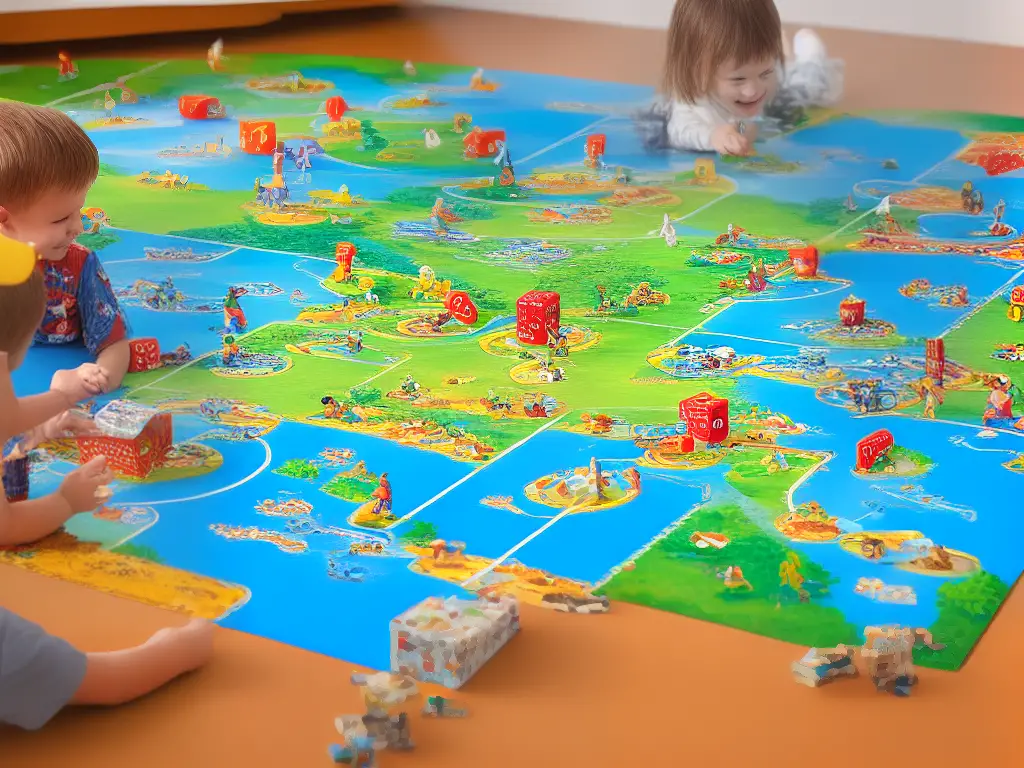Chutes and Ladders is a classic, family-friendly board game that has enchanted players of all ages for generations. The game offers a perfect blend of chance and strategy, making it both enjoyable and challenging. In this comprehensive guide, you will learn everything you need to know about Chutes and Ladders, from understanding the basics to mastering advanced strategies and exploring its rich history and cultural impact.
Understanding the Game Basics
Chutes and Ladders, also known as Snakes and Ladders, is a classic board game for 2 to 4 players. The game objective is to reach the highest square (usually 100) by rolling dice and climbing ladders while avoiding slides (or chutes). The game is suitable for all ages and relies mainly on luck, making it an enjoyable pastime for enthusiasts and hobbyists alike. This guide will help you understand the basics of Chutes and Ladders and teach you how to play.
Game Basics:
- General Concept: Players take turns rolling a die to move their tokens along a numbered spiral board with 100 spaces. If a player lands on a space that has the bottom of a ladder, they climb up to the top of the ladder. Conversely, if a player lands on a space with the top of a chute (or snake), they slide back down to the bottom. The game continues until one player reaches the highest square (usually 100) and wins the game.
- Objective: The objective of Chutes and Ladders is to be the first player to reach the highest square on the game board.
- Components:
- Game board with a numbered grid, usually 10×10.
- Tokens (or pawns) for each player, in different colors.
- One standard six-sided die.
Understanding the Game Setup:
- Set up the game board: Place the Chutes and Ladders game board on a flat surface, making sure that all players can reach it easily.
- Choose tokens: Each player selects a token of their preferred color to represent them on the game board.
- Starting positions: All players place their tokens on the first square (square number 1) of the game board.
- Decide the play order: The players can decide the order of play in any way they want, such as rolling the die to see who gets the highest number or choosing youngest to oldest.
Understanding the Spaces and Player Roles:
- Numbered Spaces: Each space on the game board is numbered, beginning at square 1 and ending at the highest square (usually 100). Players move their tokens according to the number they roll on the die.
- Ladder Spaces: Some spaces have the bottom of a ladder on them. If a player’s token lands on a space with the bottom of a ladder, their token is immediately moved to the top of the ladder, advancing them closer to the highest square.
- Chute Spaces: Some spaces have the top of a chute (or snake) on them. If a player’s token lands on a space with the top of a chute, their token is immediately moved to the bottom of the chute, forcing them to move backward in the game.
- Player Roles: Each player takes the role of controlling their token on the game board. On their turn, players roll the die and move their token accordingly. Players must strategize in hopes of landing on ladder spaces and avoiding chute spaces, while also looking for opportunities to impede their opponents’ progress. However, the outcome is primarily dictated by luck, as it is determined by the roll of the die.

Setting Up the Game
Begin by unfolding the game board and laying it on a flat surface, such as a table or the floor. Ensure that the board is fully extended and easy for all players to see and reach comfortably.
Each player will need a game piece, which is usually a small plastic or wooden character. These game pieces will be used to move along the board. Chutes and Ladders generally come with 4 different colored pieces, so make sure you have enough for all players.
The starting point for all players is the “1” square, which is located at the bottom left corner of the game board. Place each player’s game piece on this square.
To determine which player goes first, you can use various techniques such as rolling a dice or each player guessing a number and the person with the highest or lowest number starts. The order of play will continue clockwise from the starting player.
Chutes and Ladders uses a spinner or card deck to determine the moves a player will make during their turn.
- If your Chutes and Ladders game comes with a spinner, make sure the spinner is properly attached to the game board and spins freely. The spinner will have numbers 1 through 6, which determine how many spaces a player will move during their turn.
- If the game uses cards instead of a spinner, shuffle the deck thoroughly and place it face down within reach of all players. The cards will have numbers 1 through 6. Each player will draw a card during their turn to determine how many spaces they move.
Now that the game is properly set up, you’re ready to learn how to play Chutes and Ladders. Remember, the goal of the game is to be the first player to reach the “100” square located at the top right corner of the game board by climbing the ladders and avoiding the chutes. Good luck and have fun!

Playing the Game
Objective: Learn how to play Chutes and Ladders by understanding the basic game mechanics, special spaces, and actions to take during the game.
Requirements: Chutes and Ladders game board, spinner, game pieces (for each player), at least two players
Instruction:
- Set up the game board: Place the Chutes and Ladders game board in the center of the playing area. Give each player a game piece and place them on the “Start” space, which is the bottom-left corner of the board (numbered 1).
- Spinner: The game comes with a spinner that will decide your movement. Spin the spinner accurately so it rotates around the center pin at least once before stopping. The number the arrow points to is the number of spaces you move on the board during your turn.
- Taking turns:
- Player 1 starts the game by spinning the spinner. Move your game piece the respective number of spaces shown by the arrow. For example, if the arrow points at number 4, move your game piece four spaces forward.
- After player 1 has completed their turn, the next player (player 2) spins the spinner and repeats the process mentioned in step 3a.
- Continue to take turns in a clockwise direction until someone reaches the last space (number 100) on the board.
- Moving according to spinner or card results: Always move your game piece forward according to the number shown on the spinner or drawn card. If part of your move would result in landing on a space beyond space 100, you do not move your piece at all and wait for your next turn.
- Climbing Ladders: As you move along the path, you may land exactly on a space that features the bottom of a ladder. When this occurs, immediately move your game piece to the space at the top of the ladder. This is considered a “shortcut.”
- Sliding down Chutes: If you happen to land exactly on a space with the top of a chute, you must slide your game piece down to the space shown at the bottom of the chute. This is considered a setback in the game.
- Stopping at special spaces: Players must stop at the special spaces (either the bottom of a ladder or the top of a chute) and take the required actions (climbing the ladder or sliding down the chute). The game does not have any other special spaces that require specific actions.
- Winning the game: The first player to reach space 100 (by exact count) after climbing the final ladder is declared the winner. If no player reaches space 100, then the player closest to it can be declared the winner at the end of the decided number of turns.
- Playing multiple rounds: Optionally, you can play several rounds of Chutes and Ladders. To do this, simply reset the board after the completion of each round, and keep track of the winner of each game.
Remember, Chutes and Ladders is a game of chance and luck. Have fun playing and enjoy the excitement of climbing ladders and the suspense of potentially sliding down chutes.

Chutes and Ladders Variations
1. Gather the necessary equipment: You’ll need a Chutes and Ladders board, a die (dice), and game pieces (usually 2-4).
2. Set up the board: Lay the board on a flat surface, making sure each player can reach it. Each player should choose a game piece and place it on the starting square (usually labeled 1 or Start).
3. Determine the order of play: Have each player roll the die, and the person with the highest roll goes first. Play then proceeds clockwise.
4. Begin playing: On your turn, roll the die and move your game piece forward that number of spaces. If you land on a space that has the bottom of a ladder, move your piece up the ladder to the space at its top. If you land on a space with the head of a snake (or chute), move your piece down to the space at its tail.
5. Continue playing: Turns continue clockwise, with players moving their pieces according to their die roll and any ladders or chutes they encounter.
6. End the game: The game ends when a player reaches the final square (usually labeled 100 or Finish). If a player rolls a number that would take them past the final square, their turn ends, and they don’t move.
Chutes and Ladders Variations
1. Themed boards: Many versions of Chutes and Ladders exist, each with a different theme or visual design to appeal to various audiences. Examples include popular children’s characters like Dora the Explorer, Disney Princesses, and superheroes, as well as educational themes like counting, alphabet learning, and history.
2. Game variations: Some Chutes and Ladders variants add new rules, challenges, or game mechanics to keep things fresh. Examples include:
- Speedy Chutes and Ladders: Players roll two dice instead of one, allowing for faster gameplay and potentially more climbing or sliding.
- Cooperative Chutes and Ladders: All players work together to reach the finish, helping each other climb ladders and avoid chutes. This version focuses more on teamwork and less on competition.
3. Where to find Chutes and Ladders variations: You can find different versions of Chutes and Ladders at stores or online retailers that sell board games. You can also search online for printable themed boards or create your own.
Remember, the most important part of playing Chutes and Ladders or any of its variations is to have fun! Enjoy the game, and feel free to mix it up with new themes and rules to keep the excitement going.

Strategies and Tips
Section 1: How to Play Chutes and Ladders
1. Brief overview of the game and its objective
2. Setting up the board and choosing player pieces
3. Gameplay: rolling the dice, moving the pieces, and navigating chutes (snakes) and ladders
4. Winning the game: reaching the final square
Section 2: Strategies for Chutes and Ladders
1. Emphasize the luck aspect: know that there’s not much you can do to control the outcome, but play consistently for the best chances
2. Analyzing the board: understanding the locations of chutes and ladders to optimally land on ladders and avoid chutes
3. Focus on the high-impact ladders and chutes: target ladders with more vertical gain and avoid chutes that drop you further down
4. Pay attention to other players: observe their positions and contest high-impact spaces
Section 3: Tips for Enjoyment and Winning More Often
1. While the game is mostly luck-based, practicing can help you understand the board and develop a playstyle that works best for you
2. Learn from other skilled players by watching their moves and decisions
3. Experiment with different approaches to the game to keep it fresh and enjoyable
4. Maintain a positive attitude and remember that the game is meant for fun and bonding with friends and family

Playing with Children and Teaching the Game
Chutes and Ladders is a classic board game designed for young children. It is a simple, fun, and engaging game that helps promote counting and basic strategy skills. Here is a step-by-step guide on how to play Chutes and Ladders with children, as well as tips on teaching the game to various age groups.
Materials Needed:
- Chutes and Ladders board game
- Players (2 to 4 players)
- A spinner or dice
- Playing pieces (usually provided with the game)
Instructions for Playing Chutes and Ladders:
- Set up the game board: Place the Chutes and Ladders board game on a flat surface, accessible to all players. Each player should choose a playing piece and place it at the starting point, which is marked as “1” on the board.
- Determine the order of play: Players can decide who starts the game by spinning the spinner or rolling the dice. The player with the highest number goes first, followed by the next highest number, and so on.
- Begin playing the game: Each player takes a turn spinning the spinner or rolling the dice to determine how many spaces to move their playing piece forward.
- Move your playing piece: Move your playing piece clockwise on the board following the number of spaces indicated by the spinner or dice. If a player lands on a space with the bottom of a ladder, they climb up to the space at the top of the ladder. If a player lands on a space with the head of a chute, they slide down to the space at the bottom of the chute.
- Taking turns: Play continues clockwise with each player taking turns spinning the spinner or rolling the dice and moving their playing piece accordingly.
- Winning the game: The first player to reach or pass the final space, marked as “100” on the board, wins the game. In some game versions, the player must land on the “100” space exactly to win.
Teaching Chutes and Ladders to Various Age Groups:
Ages 3 to 4:
- Use simple language to explain the rules
- Practice counting together as you move the playing piece forward
- Emphasize the fun element of climbing ladders and sliding down chutes
Ages 5 to 6:
- Begin introducing basic strategy
- Encourage children to count aloud as they move their playing pieces
- Incorporate simple math to engage and challenge them (e.g., ask them how many spaces they need to climb a ladder)
Ages 7 and up:
- Discuss the importance of thinking ahead and planning moves
- Encourage children to predict outcomes based on potential moves
- Challenge them to plan their moves based on their opponents’ positions
Extra Tips:
- Be patient and supportive when teaching younger children, as the game may feel challenging at first
- Keep the game exciting by celebrating small victories like climbing a ladder or avoiding a chute
- Focus on enjoying the game and spending time together, rather than on winning or losing
By following these instructions and teaching tips, you will create a fun and engaging experience for children when playing Chutes and Ladders. It is an excellent opportunity to bond with your kids while also helping them develop essential cognitive and social skills.

History and Interesting Facts
Chutes and Ladders, also known as Snakes and Ladders, is a popular board game for people of all ages, especially loved by children due to its simple rules and engaging gameplay. In this article, we’ll explore the history and cultural significance of Chutes and Ladders, some interesting facts, and provide instructions on how to play the game.
History and Cultural Significance:
Chutes and Ladders has roots in ancient Indian board games, particularly ‘Moksha Patam’ and ‘Gyan Chauper.’ These games were designed to teach morality and the concept of karma. The early iterations featured ladders representing virtues and snakes (or chutes) representing vices. The game spread to England around the 19th century, where it was called ‘Snakes and Ladders,’ and later, it reached American shores, where it was given the name ‘Chutes and Ladders.’
Interesting Facts:
- The original Indian version of the game had squares representing virtues like faith, humility, and kindness, while other squares represented vices such as anger, arrogance, and theft.
- In the early 20th century, Milton Bradley modified the game and replaced the snakes with chutes representing artificial traps like a falling brick or a bed on which the player would unexpectedly fall. This made the game more appealing to children.
- Chutes and Ladders is based on the mathematical concept of a Markov chain, which deals with random processes that change states. The game can be used to teach basic probability and statistical concepts.
Instructions on How to Play Chutes and Ladders:
- The game requires a standard Chutes and Ladders board, which usually has 100 squares, and a die to roll, along with player pieces or tokens.
- To start, place all player tokens at the ‘Start’ position on the board.
- Players take turns rolling the die, moving their token forward the number of spaces indicated by the die roll.
- If a player’s token lands at the base of a ladder, they must climb up to the square at the top of the ladder.
- If a player’s token lands on the top of a chute (snakehead), they must slide down to the square at the bottom of the chute (snaketail).
- The first player to reach the ‘Finish’ square (usually square 100) is the winner. If a player rolls a number larger than the remaining squares to the ‘Finish,’ they must move their token forward and then backward the remaining spaces. For example, if a player is four spaces away from the finish and rolls a six, they must move forward four spaces, then move backward two spaces.
Chutes and Ladders is a fun and educational game with a rich history and interesting cultural background. While playing the game, it’s easy for both children and adults to learn the importance of practicing good morals and the concept of karma. Add a touch of excitement and enjoyment to your next game night by including this classic board game in your repertoire!

Organizing Game Nights and Social Play
Chutes and Ladders is a fun and simple board game suitable for players of all ages. It is an excellent choice for hosting a game night or social gathering with friends or family. In this guide, we will provide step-by-step instructions on how to organize a successful and enjoyable Chutes and Ladders game night.
Step 1: Choose a Location and Time
First, decide on a location and time for your game night. Make sure you have enough space to set up the game and accommodate all your guests comfortably. A living room, dining room, or even an outdoor area can be perfect for hosting game nights. Choose a date and time that works for most people, such as weekends or evenings.
Step 2: Devising a Guest List
Make a list of friends and family members who you think would like to play Chutes and Ladders. It’s essential to consider players of varying ages and skill levels when inviting guests. Remember that Chutes and Ladders can be played by 2-4 players, so plan your guest list accordingly, or have multiple game boards ready for larger groups.
Step 3: Send Invitations
Inform your guests about the event by sending out invitations at least a week in advance. You can use digital invitations, emails, text messages, or even traditional printed invitation cards. Make sure to include the date, time, location, and a short description of the game in your invitation.
Step 4: Prepare the Game and Rules
Before the game night, ensure that you have a Chutes and Ladders game board, playing pieces, and a spinner. Familiarize yourself with the rules, so you can explain them to your guests. You can also print out a simple rule sheet for everyone to reference during the game night.
Step 5: Set up Snacks and Drinks
Having snacks and drinks available can make your game night more enjoyable and help keep the energy up. Choose a variety of finger foods, such as chips, cheese and crackers, or fruits and vegetables. Provide a selection of beverages to cater to your guests’ preferences, including soft drinks, water, tea, or coffee.
Step 6: Create a Comfortable Environment
Arrange the seating around the gaming area in a way that makes it easy for everyone to see the board and socialize. Ensure there is adequate lighting and ventilation. You can also create a playlist of background music to set a fun and lively atmosphere.
Step 7: Explain the Rules and Start Playing
Begin the game night by briefly explaining Chutes and Ladders’ rules and objectives to your guests. Give everyone a chance to ask questions and clarify any uncertainties. Then, divide the players into groups (if needed), and start playing!
Step 8: Be a Good Host
As a host, your role is to ensure everyone feels included and has a great time. Encourage conversation among guests, introduce people who may not know each other, and make sure everyone understands the game rules. Keep an eye on the snacks and drinks, refilling them as needed.
Step 9: Consider Hosting a Tournament
To make the game night more competitive and engaging, consider setting up a tournament-style play. Have players or teams compete against each other, with the winners moving on to play against other winners until there is a final champion.
Step 10: Wrap Up and Plan the Next Game Night
After finishing the game(s), thank your guests for coming and invite them to share their thoughts and experiences about the game night. Discuss plans for future game nights or get suggestions for other games that everyone would like to try.
Hosting a Chutes and Ladders game night is a fantastic way to bring friends and family together for an evening of fun. By following these instructions and keeping the atmosphere lively and inclusive, your Chutes and Ladders game night is sure to be a success. Happy playing!

Online and Mobile Play
Chutes and Ladders is a popular children’s board game that involves climbing ladders and sliding down chutes while trying to be the first player to reach the finish line. The game is designed to teach basic counting and promote good sportsmanship. In addition to the physical board game, Chutes and Ladders can also be played online and on mobile devices. This guide will walk you through the process of playing the digital version of Chutes and Ladders and highlight any differences from the original board game.
Step 1: Choose a platform and download the app
- Websites: Many online gaming websites offer Chutes and Ladders as a browser-based game. You can access these by simply searching “Chutes and Ladders online game” on your preferred search engine.
- Mobile Apps: Chutes and Ladders can also be played on your smartphone or tablet. Search for “Chutes and Ladders” in your device’s app store and download the game. Some popular mobile options include “Chutes and Ladders: Classic Play” for iOS users and “Snakes and Ladders” for Android users.
Step 2: Learn the basic gameplay
The fundamentals of online or mobile Chutes and Ladders are similar to the physical board game. Here’s a quick overview:
- Players take turns rolling a virtual die by clicking or tapping on it.
- Each player’s piece moves forward the number of spaces rolled.
- If the player’s token lands on a space with a ladder bottom, they climb to the top of the ladder, skipping some squares.
- If the player’s token lands on a space with a chute’s top, they slide down to the bottom of the chute, moving backward on the board.
- The first player to reach or pass the last square (typically numbered 100) wins the game.
Step 3: Set up and start your online or mobile game
Online or digital versions of Chutes and Ladders typically have built-in instructions and tutorials to guide you through the process of setting up a new game. This often includes:
- Creating an account or signing in as a guest
- Choosing an avatar or game piece (optional)
- Selecting the number of players participating (1-4 players)
- Adjusting game settings such as difficulty level or play mode
Step 4: Understand differences from the physical board game
While gameplay in online or mobile Chutes and Ladders is largely similar to the physical board game, there may be some notable distinctions:
- Enhanced graphics and animations: In digital versions, you may notice improved graphics, animations, and sound effects for a more engaging and interactive experience.
- Multiplayer options: Online and mobile play may offer asynchronous multiplayer options, allowing you to compete against friends, family, or other users worldwide.
- In-app purchases or advertising: Some apps may include in-game purchases for extra features or have advertisements that support the developer. If you prefer an ad-free version, look for a paid or “premium” version of the game.
- Variations in names or visuals: Some app or website developers use different names for the game or redesign the visual assets, such as replacing chutes and ladders with snakes and ladders. However, the basic gameplay remains the same.
Playing Chutes and Ladders online or on a mobile device is a user-friendly and enjoyable way to experience this classic board game. As you familiarize yourself with the digital gameplay, you’ll discover enhanced features that make for an exciting and interactive virtual experience. Always remember to have fun and practice good sportsmanship while playing online or mobile games. Good luck!

Chutes and Ladders in Popular Culture
Gather the necessary materials: You will need a Chutes and Ladders game board, a set of colored game pieces (usually 2-4), and a spinner or numbered die.
Prepare the game: Lay the game board flat on a table or playing surface. Each player selects a colored game piece and places it on the starting square (usually labeled with the number 1).
Determine the order of play: Have each player spin the spinner or roll the die. The player with the highest number goes first, followed by the player with the next highest number, and so on.
Start the game: The first player spins the spinner or rolls the die and moves their game piece, following the numbers on the game board, the exact number of spaces indicated by the spinner or die.
Climbing ladders and sliding down chutes: If a player’s game piece lands on a square at the bottom of a ladder, they immediately climb the ladder and move their game piece to the square at the top of the ladder. If a player’s game piece lands on a square with the top of a chute, they immediately slide down the chute and move their game piece to the square at the bottom of the chute.
Taking turns: Players take turns in the pre-determined order, spinning the spinner or rolling the die and moving their game pieces accordingly.
Winning the game: The objective of the game is to be the first player to reach the final square (usually labeled with the highest number, like 100). A player must spin or roll the exact number needed to land on the final square. If they spin or roll a higher number, they do not move on that turn. The first player to reach the final square is the winner.
Chutes and Ladders in Popular Culture
Chutes and Ladders has been a part of popular culture since its creation in ancient India, where it was known as Moksha Patam or Snakes and Ladders. The game has been adapted and modified over time, leaving a significant impression on people due to its easy gameplay and the lessons it teaches about life.
- Movies: Chutes and Ladders has made appearances in various films, such as Jumanji (1995), where the concept of players being affected by the board game’s elements is similar to the ladders and chutes in Chutes and Ladders.
- Books: Several children’s books have featured Chutes and Ladders-like elements, particularly in stories where characters must navigate a world filled with obstacles and shortcuts to reach their goals.
- Television: The game has been featured in various TV shows, both in the form of actual gameplay and as a metaphor for life’s ups and downs. For example, in the popular sitcom Friends, Ross uses the game to explain the complexities of his romantic life.
- Music: In 2013, the musician Bruce Hornsby released a song titled “Chutes and Ladders,” which discusses the role of luck and chance in life, drawing a parallel to the gameplay of Chutes and Ladders.
- Cultural Influence: The game has been used to teach children about the complexities and challenges of life, with the ladders representing positive experiences and the chutes representing setbacks. The game is often used as a tool for teaching moral lessons, as it demonstrates how one’s choices can lead to progress or setbacks.
In conclusion, Chutes and Ladders have left a lasting impression on people through its presence in various forms of popular culture. Its simple gameplay and the life lessons it teaches continue to resonate with audiences worldwide, making it a beloved and timeless game.